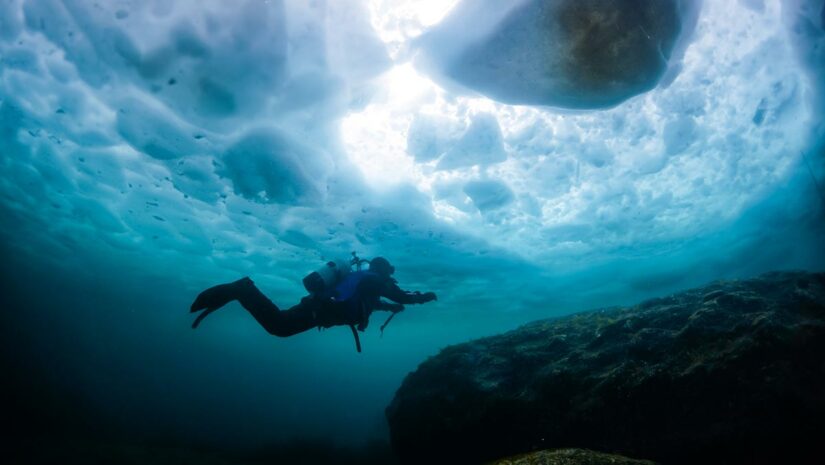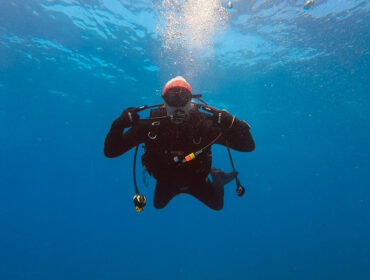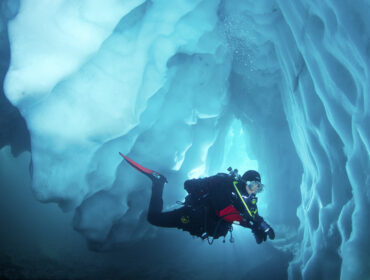Diving beneath the icy surface of the Arctic offers a diving experience unlike any other. Yet, the preparation, gear, and awareness required for such an adventure are extensive. This article dives into the world of ice diving, from its frosty charm and unique challenges to the vital conservation efforts preserving the Arctic’s delicate ecosystem.
What is ice diving?
Ice diving is a specialized form of scuba diving where divers submerge beneath frozen water surfaces, typically in lakes or ponds. The underwater environment beneath the ice is serene, with a crystal-clear view often untouched by wind or other disturbances. This surreal experience isn’t just about the visuals; the silence and serenity are profound.
Diving beneath an ice ceiling means that you usually only have one entry and exit point, making safety a top priority. Special training and equipment, including dry suits to protect against the cold, are essential. Ice diving offers a unique experience but demands respect for its potential risks.

Preparing for the Arctic Plunge
Ice diving is no ordinary scuba diving adventure—it’s an expedition into an untouched world beneath a frozen water surface. With the thrill will come unique challenges that demand a lot of preparation and respect for the risks.
Safety Considerations
The key difference between open water and ice diving is the icy ceiling above, limiting your exit to a single point. This makes safety precautions utterly important. Every diver who ventures under the cold surface must be safely connected to a safety rope (tether line). This vital cable has two functions: guiding divers to the exit hole and offering quick help when needed. Surface support divers/assistants must maintain constant awareness because they are responsible for maintaining these lifelines and safeguarding the safety of divers below.
Furthermore, diving in such difficult conditions should never be done alone. The buddy system is critical, as having a companion underwater ensures frequent checks, providing an extra layer of security. Finally, divers are strongly urged to attend specialist ice diving courses in order to efficiently manage the obstacles of this freezing environment.
Equipment Considerations
When gearing up for an ice dive, the selection of equipment is very important to ensure both safety and a comfortable dive. Foremost are drysuits, distinct from wetsuits, as they are specifically designed to keep you completely dry during the dive, ensuring your body remains untouched by the ice-cold water. Insulated for warmth and equipped with pockets for any necessary added weight, drysuits are indispensable in icy conditions.
Additionally, the chilling waters can cause regular regulators to lose their strength or even freeze. Therefore, specialized ice diving regulators, designed to endure and operate flawlessly in freezing temperatures, are essential, minimizing the threat of an unexpected free flow. For example, the Apeks MTX-R regulator is specifically designed for cold water diving.
Pre-Dive Activities
Before, during and after the dive – you should make sure you don’t get too cold. To ensure this, we recommend you wear thermal layers. Thermal layers, worn beneath dry suits, absorb sweat and keep you toasty. There are special undergarments and thermal layers available for dry suits. A brief pre-dive warm-up is also recommended as it activates metabolism, stabilizing core temperature. Proper nutrition, like warm beverages and a hearty meal, provide additional warmth. Post-dive, it’s vital to quickly change into dry, warm clothes, making sure you don’t get hypothermia.
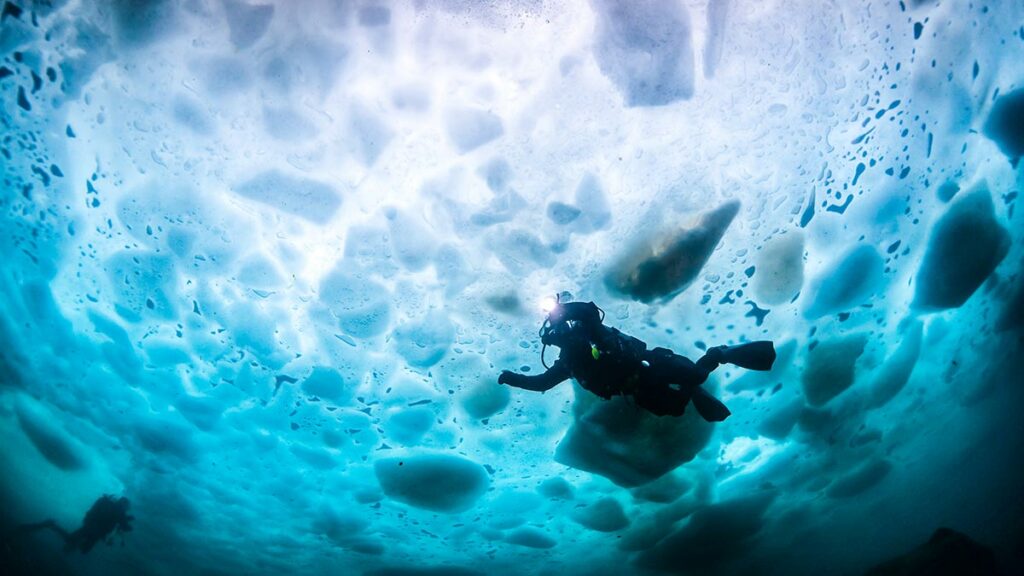
Beneath the Ice: The Dive Experience
The ice diving adventure starts long before you’re in the cold water. Your first step is to select a suitable location, ensuring the ice’s thickness meets safety standards. The ice should typically be at least four inches thick for a single diver and thicker for groups.
Once a spot is chosen, the process of cutting begins. Using an ice saw or a powered auger, divers carve out an entry hole, usually triangular (each side 6 feet) or rectangular (6 feet x 3 feet) in shape, ensuring its size is comfortable for both the divers and the necessary equipment.
As the hole is prepared, divers ready themselves. The equipment is checked with particular attention to the specialized regulators and the safety lines. Each diver then harnesses themselves, ensuring a secure attachment to the lifeline above.
With safety checks complete, divers, accompanied by their buddies, approach the freshly cut hole. Taking a moment to mentally prepare, they then decend, leaving the world above for the surreal ice realm below. The ice ceiling transforms into their sky, and the cool, clear waters grip them in a tranquil grasp unlike any other scuba dive experience.

Ice Diving Safety and Emergency Procedures
Because of the specific problems that come with ice diving, detailed protocols and an understanding of potential problems are needed.
Safety Lines
Every diver must be firmly attached to a safety line, which serves as a physical guide back to the exit hole. It is non-negotiable and ensures immediate aid if needed. A surface support team constantly monitors these lifelines and is ready to respond at any time.
Buddy System
Dive beneath the ice is a group effort. Buddies not only keep you company, but they also act as an extra layer of protection, assuring regular checks and fast response in the case of an issue.
Regular Checks
Frequent equipment inspections, particularly of regulators and valves, lower the chance of failure. In cold temperatures, equipment can perform erratically, thus extreme caution is required.
Emergency Signals
Establish clear underwater communication signals with your friend and the surface team. When verbal communication is not feasible, precise signaling can make all the difference.
Post Dive Protocol
After the dive, divers should immediately check in with the surface team and their buddy. A quick change into warm garments can prevent hypothermia, and a debrief ensures that everyone is aware of any problems or observations.
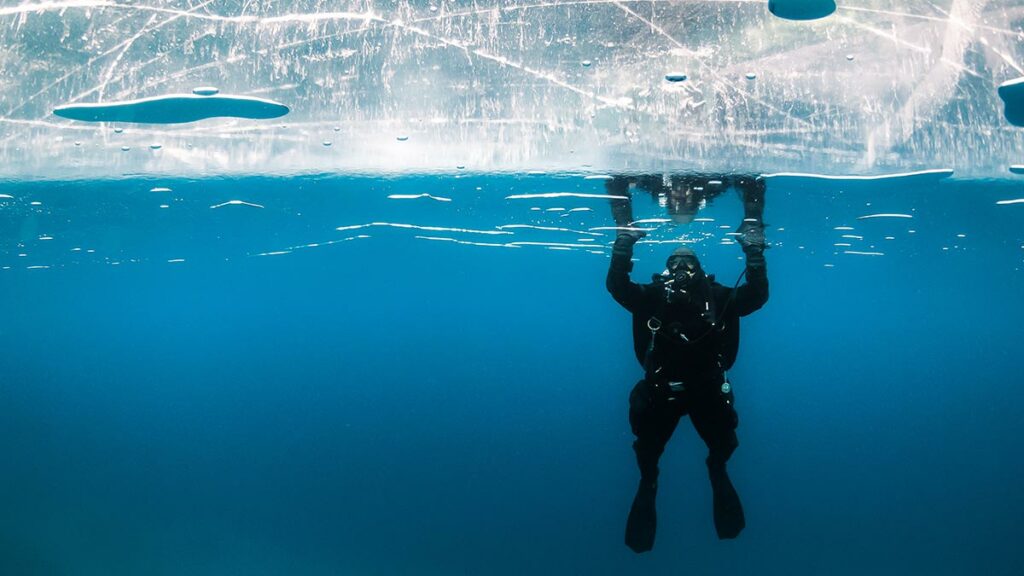
Gear for Ice Diving
In this article, we have already mentioned some necessary equipment for ice diving. Here’s a rundown of all the essential equipment for a safe and comfortable ice diving experience:
Drysuits & Thermal Undergarments
The cornerstone of ice diving attire, drysuits differ from the common wetsuits. Designed to prevent water from contacting the skin, they are insulated and come equipped with seals at the neck and wrists. Their construction often includes pockets for additional weights or tools. Beneath the dry suit, divers wear thermal undergarments that provide added insulation, wicking away moisture and ensuring warmth in the freezing environment.
Specialized Regulators
Cold water poses a risk to regular scuba regulators, as they can freeze and cause free-flowing air. Ice diving regulators counteract this because they are environmentally sealed and optimized to function in near-freezing temperatures.
Safety Lines & Harnesses
An indispensable component, safety lines ensure divers can safely navigate their way back to the entry point. Attached securely via harnesses, these lines are monitored by surface teams, providing an additional layer of security and guidance.
Hoods, Gloves, and Boots
Exposure protection from the cold extends beyond the body. Thick, insulated hoods keep the head warm, and good gloves and boots keep the hands and feet protected from the piercing cold.
Ice Cutting Tools
Preparing the dive site involves cutting through thick layers of ice. Tools like powered augers or ice saws are crucial for this, creating entry and exit points for divers.
Dive Lights
The world beneath the ice can be dim. High-quality dive lights illuminate the surroundings, revealing the beauty hidden in the depths and aid in communication with your dive buddies.
Backup Gear
Given the challenging environment, carrying backup items like masks, mouthpieces, or even a secondary regulator can be a lifesaver in the event of equipment malfunction.

Preserving the Arctic’s Fragile Ecosystem
Imagine the Arctic as a giant snow globe, filled with icy waters and amazing creatures (like polar bears) that can’t be found anywhere else. This underwater world is like a delicate puzzle where everything fits just right. But, like a puzzle, if you lose even one piece, the whole picture can change.
Sadly, things like pollution, overfishing, and warmer weather are causing problems in this icy wonderland. The ice is melting faster, and this can confuse and harm the animals that call it home. But there’s good news also. People all around the world are trying to help. They’re making rules to protect fish, cleaning up the waters, and studying the Arctic to learn more about how to save it. These measures have been implemented already:
Marine Protected Areas
People have made certain parts of the Arctic into safe zones, kind of like nature parks, where animals can live without too many disturbances. One such place is the Northeast Greenland National Park—it’s huge!
Regulation of Fishing
Overfishing can significantly harm the delicate balance of the Arctic marine ecosystem. International agreements, such as the Central Arctic Ocean (CAO) fishing moratorium, prevent unregulated fishing in the region.
Climate Change Mitigation
Given the significant impact of global warming on Arctic ice melt, international efforts, such as the Paris Agreement, play an indirect yet crucial role in Arctic conservation by addressing the root causes of climate change.
Oil Drilling Bans
Certain areas of the Arctic have seen bans or restrictions on oil and gas exploration and extraction due to the potential for spills and the environmental sensitivity of the region.
Indigenous Rights and Involvement
Indigenous communities have lived in the Arctic for millennia, and they possess invaluable knowledge about the ecosystem. Their involvement in conservation efforts, management strategies, and decision-making processes is critical.
Scientific Research
Institutions and countries collaborate in Arctic research to monitor changes, understand the ecosystem better, and inform conservation strategies. Organizations like the Arctic Council play a pivotal role in this, bringing together Arctic states, indigenous communities, and other stakeholders.
Clean-Up Initiatives
Efforts to clean up pollution and reduce marine debris, especially plastic, are ongoing.
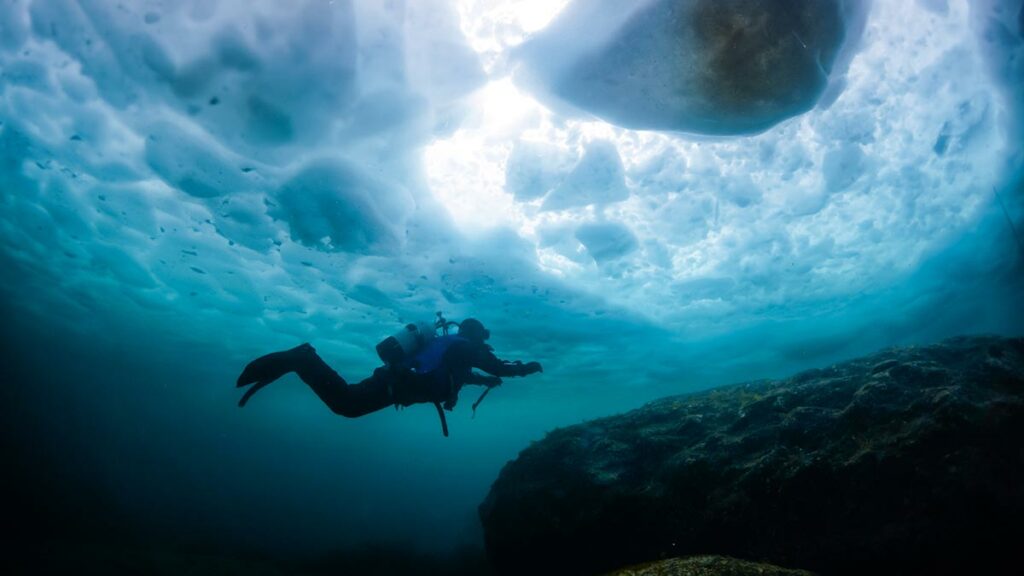
Tips for Planning an Ice Diving Expedition
When planning an ice diving expedition, it’s crucial to start with thorough research. Different locations offer unique sights and challenges, so selecting a spot that suits your experience level is important. If you’re new to this chilly adventure, consider enrolling in a specialized program.
The right equipment is an absolute must, from drysuits and specialized regulators to thermal. Prioritize safety by always diving with a buddy, maintaining surface support, and using safety lines and harnesses diligently. Being proactive about emergencies means familiarizing yourself with the nearest rescue services and having a first-aid kit on hand.
As you embark on this icy journey, remember to tread gently and respect the fragile Arctic ecosystem. Keep an eye on weather updates, as conditions can shift unexpectedly, impacting both visibility and safety. Ultimately, thorough preparation ensures that your expedition not only offers you an incredible adventure but remains safe from start to finish.
Ice Diving Frequently Asked Questions
Ice divers avoid hypothermia by wearing specialized drysuits that keep water out and body heat in. These suits are layered with insulating materials and sealed cuffs, preventing cold water from contacting the skin. Additionally, divers use thermal undergarments, maintain physical activity, and limit dive times to stay safe in frigid waters.
Ice dives typically last between 20 to 40 minutes, balancing the risks of hypothermia and air consumption. Divers meticulously plan their routes, communicate with teammates, and adhere to strict safety protocols. Cold water’s effects are managed by wearing appropriate gear and maintaining physical activity to ensure a safe and enjoyable experience.
Conclusion
Experiencing the Arctic’s chilling depths is an exciting dive adventure. We must keep in mind our role in protecting this vulnerable ecosystem as we enjoy all the underwater beauty and navigate the obstacles of ice diving. Every diver, armed with knowledge, respect, and the proper equipment, may ensure that this icy realm stays captivating for future generations.

